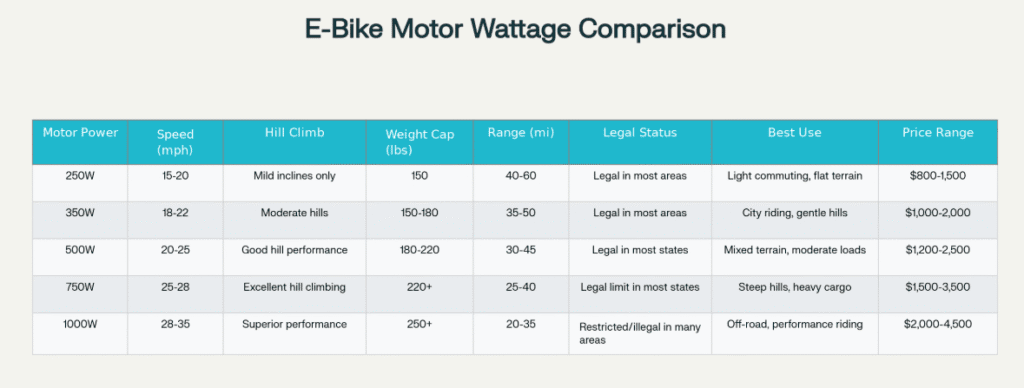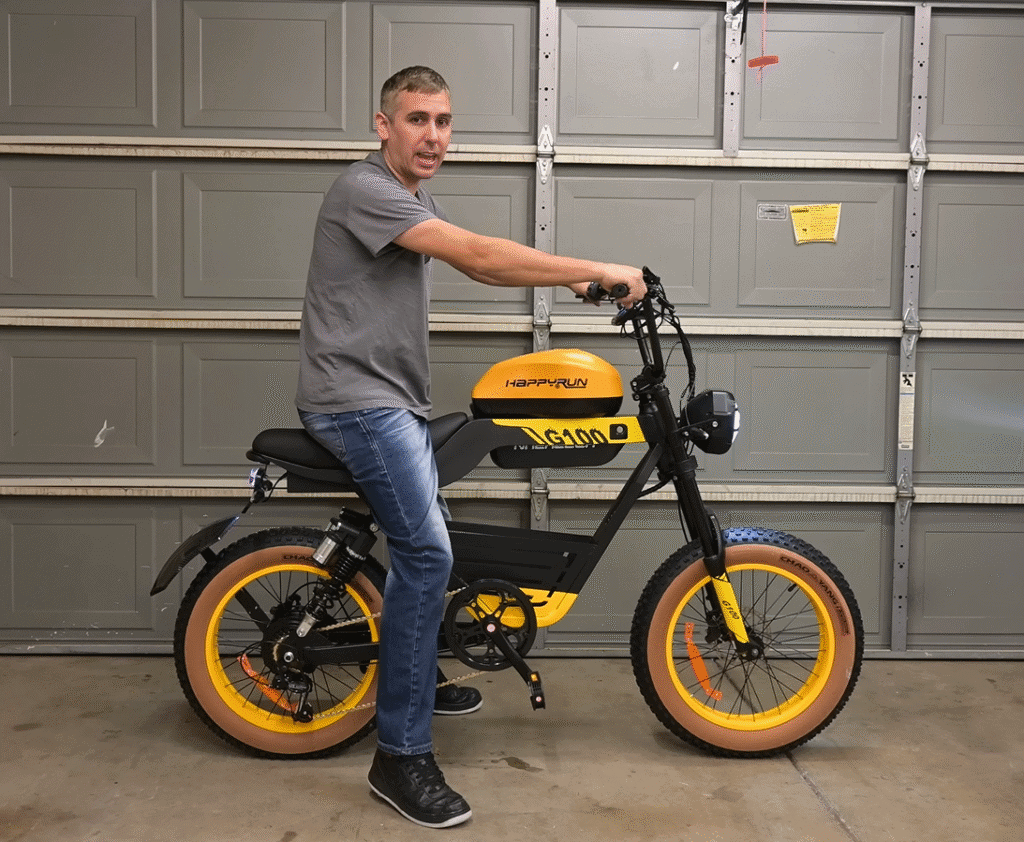Higher-wattage electric bikes are not automatically better for every rider. While higher wattage motors deliver more power, speed, and hill-climbing ability, they also consume battery faster, cost more, and may face legal restrictions. The optimal wattage depends on your riding needs, terrain, weight, and local regulations. Motor wattage between 500W-750W typically provides the best balance of performance and efficiency for most riders, offering sufficient power without sacrificing battery life or legal compliance.
Understanding the relationship between electric bike motor power and real-world performance helps you make informed decisions that match your specific riding requirements and budget constraints.
What Electric Bike Wattage Really Means
Power Output Fundamentals
Electric bike wattage measures the power output of the motor, indicating how much energy it can deliver to assist your pedaling. This rating represents the motor’s continuous power capability, which differs from peak power that motors can achieve briefly during demanding situations like steep climbs.
Motor power directly influences acceleration, top speed, and torque delivery. A 250W motor provides gentle assistance suitable for flat terrain, while a 750W motor offers robust performance for challenging conditions. The wattage rating serves as a baseline for comparing different motors, though actual performance depends on multiple factors including battery voltage, controller efficiency, and motor placement.
Continuous vs Peak Power Ratings
Most electric bike motors can exceed their rated wattage temporarily when additional power is needed. A 500W motor might deliver 750W during peak demand, while a 750W motor could reach 1000W for short bursts. This peak capability helps with sudden acceleration or steep climbs without requiring a permanently higher-rated motor.
Understanding this distinction helps explain why some lower-wattage motors can perform surprisingly well in demanding situations. The controller and battery system work together to manage power delivery, ensuring optimal performance while protecting components from damage.
How Higher Wattage Affects Performance
Speed and Acceleration Benefits
Higher wattage electric bikes deliver noticeably faster acceleration and higher top speeds. A 250W motor typically reaches 15-20 mph, while a 750W motor can achieve 25-28 mph, and 1000W motors may exceed 30 mph under optimal conditions.
The acceleration difference becomes most apparent when starting from stops or navigating traffic. Higher wattage motors provide more immediate power response, making city riding smoother and safer. This enhanced performance particularly benefits heavier riders or those carrying cargo who need extra assistance to maintain speed.
Hill Climbing Capabilities
Motor wattage significantly impacts hill-climbing performance. A 250W motor struggles with grades steeper than 10%, while a 500W motor handles moderate hills comfortably. 750W motors excel on steep terrain, providing confidence and capability for challenging routes.
The torque delivery from higher wattage motors means less pedaling effort required on inclines. Riders can maintain higher speeds up hills without overexerting themselves, making previously difficult routes accessible.

Battery Life vs Motor Power Trade-offs

Range Implications of Higher Wattage
Higher wattage motors consume more battery power, directly reducing range per charge. A 250W motor might deliver 40-60 miles of range, while a 750W motor typically provides 25-40 miles under similar conditions.
This trade-off becomes more pronounced at higher speeds and during aggressive acceleration. Battery efficiency decreases significantly when motors operate at peak output, making range planning crucial for longer rides.
Optimizing Efficiency vs Power
The relationship between speed and battery consumption is exponential rather than linear. Riding at 25 mph can consume twice as much battery as maintaining 15 mph, regardless of motor wattage. Lower assist levels and moderate speeds maximize range while still providing meaningful power assistance.
Mid-drive motors generally offer better efficiency than hub motors by leveraging the bike’s gearing system. This allows the motor to operate in its optimal RPM range more consistently, improving overall battery performance.
Legal Considerations and Restrictions
Federal and State Wattage Limits
Most US states limit electric bikes to 750W maximum power to qualify for bicycle classification rather than motor vehicle status. California electric bike laws specifically require motors not exceed 750 watts to remain in the three legal e-bike classes.
Six states allow 1000W electric bikes: Georgia, Kansas, Minnesota, Oklahoma, Oregon, and South Carolina. However, even in these states, local jurisdictions may impose additional restrictions on trails, bike paths, or specific areas.
Consequences of Exceeding Legal Limits
Electric bikes exceeding legal wattage limits may be classified as mopeds or motorcycles, requiring registration, insurance, and driver’s licenses. This reclassification also restricts where you can ride, eliminating access to bike lanes, trails, and multi-use paths.
Recent legislation like California’s SB 1271 specifically targets illegal modifications and over-powered e-bikes, with penalties for both sellers and riders of non-compliant vehicles. Understanding local regulations helps avoid legal complications and ensures continued access to cycling infrastructure.
Motor Placement: Mid-Drive vs Hub Motors
Performance Differences by Type
Mid-drive motors typically provide more efficient power delivery than hub motors by working through the bike’s gearing system. A 350W mid-drive motor can outperform a 500W hub motor in climbing situations due to mechanical advantage from gears.
Hub motors offer simplicity and lower maintenance but sacrifice some efficiency, especially on hills. They provide a different ride feel, often described as being “pushed” rather than the natural pedaling assistance of mid-drives.
Weight Distribution and Handling
Mid-drive motors maintain better bike balance by positioning weight centrally near the bottom bracket. This preserves natural handling characteristics and provides more stable cornering and climbing performance.
Hub motors add significant weight to either the front or rear wheel, potentially affecting handling and balance. Rear hub motors combined with rear-mounted batteries can create very rear-heavy bikes that handle differently than traditional bicycles.
Choosing the Right Wattage for Your Needs
Rider Weight and Terrain Considerations
Lighter riders (under 150 lbs) often find 250W-350W motors adequate for flat to moderate terrain. Average weight riders (150-200 lbs) benefit from 500W motors for versatility across mixed terrain.
Heavier riders (200+ lbs) or those carrying cargo should consider 750W motors for optimal performance. The additional power ensures comfortable riding without straining the motor or draining batteries excessively.
Intended Use Cases
Urban commuting on mostly flat terrain works well with 350W-500W motors, providing adequate speed and range for daily transportation needs. Mixed terrain riding benefits from 500W-750W motors that handle both city streets and moderate hills effectively.
Off-road adventures and steep terrain riding often require 750W or higher for confident performance. However, consider local trail regulations, as many restrict or prohibit electric bikes entirely regardless of wattage.
Cost vs Performance Analysis
Price Scaling with Wattage
Electric bike prices generally increase with motor wattage, though the relationship isn’t perfectly linear. 250W bikes start around $800-1,500, while 750W models typically range from $1,500-3,500. The price difference reflects not just motor costs but also stronger frames, larger batteries, and premium components needed to handle higher power.
Higher wattage motors require more robust supporting systems, including enhanced brakes, stronger wheels, and more sophisticated controllers. These upgrades contribute significantly to overall cost beyond just the motor itself.
Long-term Value Considerations
Higher wattage electric bikes may offer better long-term value for demanding riders despite higher initial costs. The enhanced performance and durability often justify the premium for those who regularly tackle challenging terrain or heavy loads.
Lower wattage options provide excellent value for casual riders who prioritize efficiency and range over peak performance. The reduced complexity often means lower maintenance costs and longer component life.
Real-World Performance Scenarios
Daily Commuting Requirements
Most urban commuters find 500W motors provide the ideal balance of performance and efficiency. This power level handles moderate hills, offers good acceleration in traffic, and maintains reasonable battery range for daily use. Higher wattage becomes beneficial for particularly hilly commute routes or when carrying heavy work equipment.
Throttle availability on many 500W-750W bikes provides valuable assistance during stop-and-go traffic or when starting on hills. This feature proves especially useful for commuters dealing with frequent traffic signals or crowded bike lanes.
Recreational Riding Applications
Weekend recreational riders benefit from 500W-750W motors that expand accessible terrain beyond what human power alone allows. These power levels enable exploration of hillier areas and longer distances while maintaining enjoyable effort levels.
Performance-oriented riders seeking maximum capability often prefer 750W-1000W motors despite legal and range limitations. These high-powered systems excel for experienced cyclists wanting electric assistance for extreme terrain or competitive applications.
Maintenance and Reliability Factors
Component Stress and Longevity
Higher wattage motors place greater stress on drivetrain components, particularly chains, cassettes, and derailleurs on mid-drive systems. This increased wear may require more frequent maintenance and component replacement compared to lower-powered systems.
Battery life also correlates with motor demands, as high-power applications can stress battery cells more significantly. Lower wattage motors operating within comfortable limits often deliver longer battery service life and more consistent performance over time.
Service and Support Considerations
Popular wattage ranges (250W-750W) typically have better parts availability and service network support than extreme high-power systems. Mainstream motors use common components and protocols, making repairs and upgrades more accessible and affordable.
Specialty high-wattage systems may require manufacturer-specific parts and expertise, potentially increasing service costs and downtime when repairs are needed. Consider local service capabilities when choosing motor power levels beyond standard offerings.
Making the Right Choice
Matching Power to Purpose
The question “is higher wattage better” ultimately depends on individual riding needs rather than absolute performance metrics. Electric bike wattage should match your typical terrain, rider weight, cargo requirements, and local legal restrictions.
Conservative wattage choices (350W-500W) work excellently for most riders, providing adequate performance with better efficiency, longer range, and broader legal acceptance. These motors handle typical riding scenarios effectively while maintaining practical daily-use characteristics.
Higher wattage motors (750W+) make sense for specific applications: steep terrain, heavy loads, larger riders, or performance-focused applications where power trumps efficiency concerns. However, they require accepting trade-offs in range, cost, and potentially legal compliance.
Consider test riding different wattage levels to experience firsthand how motor power affects your riding experience. The “best” wattage is the one that meets your needs without unnecessary compromises in other areas that matter to your specific use case.